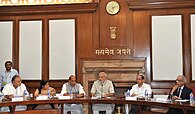
Morarji Ranchhodji Desai was an Indian independence activist and politician who served as the 4th Prime Minister of India between 1977 and 1979 leading the government formed by the Janata Party. During his long career in politics, he held many important posts in government such as Chief Minister of Bombay State, Home Minister, Finance Minister and 2nd Deputy Prime Minister of India.

Manmohan Singh is an Indian politician, economist, academician and bureaucrat who served as the 13th Prime Minister of India from 2004 to 2014. He is the third longest-serving prime minister after Jawaharlal Nehru and Indira Gandhi. A member of the Indian National Congress, Singh was the first Sikh and non-Hindu prime minister of India. He was also the first prime minister since Jawaharlal Nehru to be re-elected after completing a full five-year term.

Palaniappan Chidambaram, better known as P. Chidambaram, is an Indian politician and lawyer who currently serves as Member of Parliament, Rajya Sabha. He served as the Chairman of the Parliamentary Standing Committee on Home Affairs from 2017 to 2018. And also served Interim Deputy Leader of Opposition in Rajya Sabha from 2022 to 2023 under Mallikarjun Kharge.
The Economic Survey of India is an annual document of the Ministry of Finance, Government of India. The Department of Economic Affairs, Ministry of Finance presents the Survey in the Parliament every year, just before the Union Budget. It is prepared under the guidance of the Chief Economic Adviser of India. This document is presented to both Houses of Parliament during the Budget Session.

The Minister of Finance is the head of the Ministry of Finance of the Government of India. One of the senior most offices of the Union Cabinet, the finance minister is responsible for the fiscal policy of the government. A key duty of the Finance Minister is to present the annual Union Budget in Parliament, detailing the government's plan for taxation and spending in the coming financial year. Through the Budget, the finance minister also outlines allocations to all the ministries and departments. The Minister is assisted by the Minister of State for Finance and the junior Deputy Minister of Finance.

The Ministry of Defence (MoD) is charged with coordinating and supervising all agencies and functions of the government relating directly to national security and the Indian Armed Forces. The President of India is the ceremonial commander-in-chief of the armed forces of the country. The Ministry of Defence provides policy framework and resources to the armed forces to discharge their responsibility in the context of the defence of the country. The Indian Armed Forces and Indian Coast Guard under the Ministry of Defence are primarily responsible for ensuring the territorial integrity of India.
Budget Day is the day that a government presents its budget to a legislature for approval, in a ceremonial fashion. It only exists in some countries of the world.

Nirmala Sitharaman is an Indian economist, politician and a senior leader of the Bharatiya Janata Party (BJP) serving as the Minister of Finance and Minister of Corporate Affairs of the Government of India since 2019. She is a member of the Rajya Sabha, the upper house of the Indian Parliament, representing Karnataka since 2016 and previously represented Andhra Pradesh from 2014 to 2016. Sitharaman previously served as the 28th Defence Minister from 2017 to 2019, thereby becoming India's second female defence minister and the second female finance minister after Indira Gandhi, and the first full-time female minister to hold each of those portfolios. She served as junior minister in the Modi ministry between 2014 and 2017, holding successive positions, first for her dual appointment as the Minister of State in the Ministry of Finance and the Minister of State in the Ministry of Corporate Affairs from May to November 2014, and then as the Minister of State for the Ministry of Commerce and Industry from May 2014 to September 2017, before being elevated to senior posts within the Union Cabinet.

The 2016 Union budget of India is the annual financial statement of India for the fiscal year 2016–2017. It was presented before the parliament on 29 February 2016 by the Finance Minister of India, Arun Jaitley. The printing of the budget documents began with a traditional Halwa ceremony on 19 February 2016. For Budget 2016-17, the government invited suggestions from citizens through Twitter for the first time, even conducting a series of polls to gauge public priorities and expectations from the Budget.
Disinvestment in Public sector undertakings in India is a process of public asset sales done by the President of India on behalf of the Government of India. It can be directly offered for sale to the private sector or indirectly done through a bidding process. The Public Enterprises Survey (2015–16), brought out by the Department of Public Enterprises, Ministry of Heavy Industries, & Government of India on the performance of Central Public Sector Enterprises was placed in both the Houses of Parliament on 21 March 2017. There were 331 CPSEs in 2017-18, out of which 257 were in operation. The remaining 74 of the CPSEs were being established.
The 2017 Union Budget of India is the
The 2018 Union Budget of India was the annual financial statement (AFS), demand for grants, appropriation bill and finance bill of India for the financial year 2018–19.
The 2019 Interim Union Budget of India was presented by acting Finance Minister Piyush Goyal on 1 February 2019. The government introduced Pradhan Mantri Kisan Samman Nidhi and Pradhan Mantri Shram Yogi Mandhan.
The 2019 Union Budget of India was presented by Finance Minister, Nirmala Sitharaman on 5 July 2019, 11 am as her maiden budget. This was the first budget of Narendra Modi led NDA government second term.
The 2020 Union Budget of India was presented by the Finance Minister, Nirmala Sitharaman on 1 February 2020, as her second budget. This is the second budget of Narendra Modi-led NDA government's second term. The Economic Survey for 2019–2020 was released on 31 January 2020, a day before the budget. Before the budget speech the report of the 15th Finance Commission was tabled by the Finance Minister.

The Pradhan Mantri Matsya Sampada Yojana (PMMSY)(http://pmmsy.dof.gov.in/) is an initiative launched by the Government of India to establish a comprehensive framework and reduce infrastructural gaps in the fisheries sector. The scheme was announced by the Finance Minister, Nirmala Sitharaman during her speech in the parliament of India while presenting the Union budget for 2019–20 on 5 July 2019. The government intends to place India in the first place in Fish production and processing by implementing Neeli Kranti (transl. Blue Revolution). This scheme is in line with governments aim to double the farmers' income by 2022–23.
The 2021 Union Budget of India was presented by the Minister of Finance on 1 February 2021. The budget is the first one to be presented orally due to ongoing COVID pandemic.
The 2022 Union Budget of India was presented by the Minister of Finance Nirmala Sitharaman on 1 February 2022, as her fourth budget. This is the third budget of Narendra Modi-led NDA government's second term. The Economic Survey for 2021–2022 was released on 31 January 2022, a day before the budget.
The 2023 Union Budget of India was presented by the Minister of Finance of India on February 1, 2023. This was the fourth budget of Narendra Modi-led NDA government's second term, starting from 2020. The Economic Survey for 2022–2023 was released on January 31, 2023 before the budget.





















